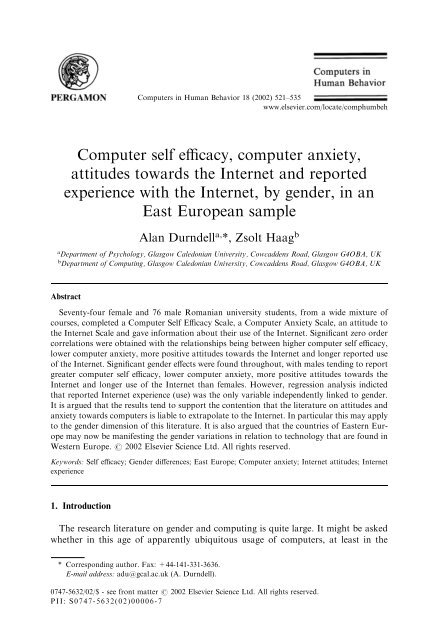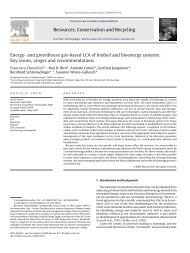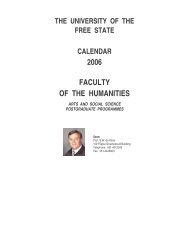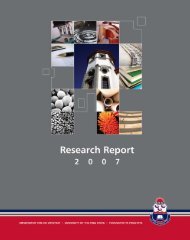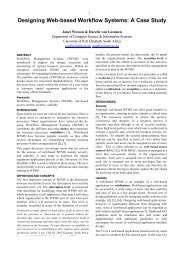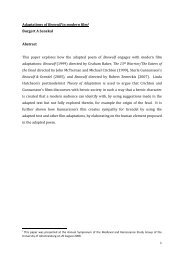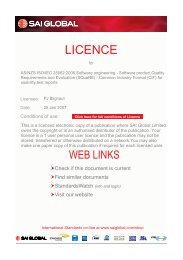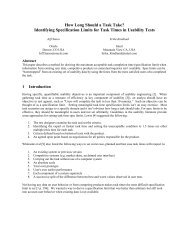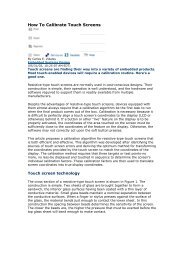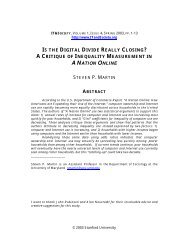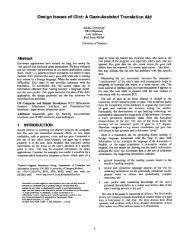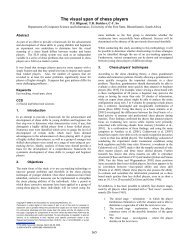Computer self efficacy, computer anxiety, attitudes towards the ...
Computer self efficacy, computer anxiety, attitudes towards the ...
Computer self efficacy, computer anxiety, attitudes towards the ...
You also want an ePaper? Increase the reach of your titles
YUMPU automatically turns print PDFs into web optimized ePapers that Google loves.
1. Concerned aspects of Internet experience, namely participants reportedlength of time in months as an Internet user and reported uses to which <strong>the</strong>Internet was put.2. The <strong>Computer</strong> Anxiety Rating Scale (CARS, see Appendix A) was used toassess an individual’s level of <strong>computer</strong> <strong>anxiety</strong>. The CARSis a 19 item<strong>self</strong>-report inventory, approximately balanced for direction of answer,designed and validated by Heinssen, Glass, and Knight (1987). Items eightand 17 in <strong>the</strong> CARShad to be changed slightly. Participants responded ona five point Likert type scale (1=strongly disagree; 3=undecided;5=strongly agree). Total score could range from 19, indicating a low levelof <strong>computer</strong> <strong>anxiety</strong>, to 95, which would indicate a high degree of <strong>computer</strong><strong>anxiety</strong>.3. The Internet Attitude Scale (IAS, see Appendix B) is a modified version of<strong>the</strong> <strong>Computer</strong> Attitude Scale, developed and validated by Nickell and Pinto(1986). In order to measure <strong>attitudes</strong> <strong>towards</strong> <strong>the</strong> Internet, <strong>the</strong> word ‘<strong>computer</strong>’was replaced with ‘<strong>the</strong> Internet’ throughout <strong>the</strong> scale. For example,item 5 ‘Soon our lives will be controlled by <strong>computer</strong>s’ became ‘Soon ourlives will be controlled by <strong>the</strong> Internet’. The IASconsists of 20 statements,balanced for direction of response, rated on a five point Likert type scale.Scores on <strong>the</strong> IAS could range from 20, indicating an extremely negativeattitude <strong>towards</strong> <strong>the</strong> Internet, to a score of 100, which would imply anextremely positive attitude <strong>towards</strong> <strong>the</strong> Internet.4. Torkzadeh and Koufteros’s (1994) <strong>Computer</strong> Self Efficacy (CSE) Scale,with <strong>the</strong> following slight modification: it was decided that <strong>the</strong> three ‘mainframe’statements were not needed, as <strong>the</strong> move to stand alone machineshad made <strong>the</strong> concept irrelevant. Two additional statements that were originallyused by Murphy, Coover, and Owen (1989) were included, giving atotal of 29 statements. The items are shown in Appendix C. Each item waspreceded by <strong>the</strong> phrase ‘I feel confident’. A five point Likert type formatwas employed (1=strongly disagree to 5=strongly agree). All items werepositively worded statements that reflected a variety of <strong>computer</strong> relatedskills. High scores indicated a high degree of confidence in one’s ability touse <strong>computer</strong>s (see Durndell et al., 2000). Scores could range between 29and 145.All items were translated into Romanian by a completely bilingual Romanianworking in Scotland who spoke English like a native speaker. This translation wasindependently checked by a bilingual Romanian in Romania.2.3. ProcedureA. Durndell, Z. Haag / <strong>Computer</strong>s in Human Behavior 18 (2002) 521–535 525The materials were distributed in teaching situations in a Romanian university<strong>towards</strong> <strong>the</strong> end of <strong>the</strong> academic year. All participants were volunteers. Completedquestionnaires were sent to <strong>the</strong> UK, and data analysis was <strong>the</strong>n carried out usingSPSS.
526 A. Durndell, Z. Haag / <strong>Computer</strong>s in Human Behavior 18 (2002) 521–5353. ResultsZero order correlations for <strong>the</strong> whole sample between <strong>the</strong> CARS, IAS and <strong>the</strong>CSE Scales and reported time of use of <strong>the</strong> Internet in months are shown inTable 1. Means and SD’s are also displayed.Zero order correlations for <strong>the</strong> whole sample between components of <strong>the</strong> CSEscale: all three correlations between <strong>the</strong> three components of <strong>the</strong> total CSE scoreidentified by Torkzadeh and Koufteros (1994) were highly significant (P>0.001).Beginning skills CSE correlated at +0.81 with advanced skills CSE, beginningskills CSE correlated at +0.89 with file and software skills CSE, and advancedskills CSE correlated at +0.86 with file and software skills CSE.Reliability: <strong>the</strong> reliability of <strong>the</strong> three main scales was assessed using alpha: for <strong>the</strong>AIS, <strong>the</strong> alpha was 0.8977, and if single items were deleted <strong>the</strong> minimum alphawas 0.8883. For <strong>the</strong> CSE, <strong>the</strong> alpha was 0.9696, and if single items were deleted<strong>the</strong> minimum alpha was 0.9677. for <strong>the</strong> CARS, <strong>the</strong> alpha was 0.9089, and if singleitems were deleted <strong>the</strong> minimum alpha was 0.9001. The corrected item–total correlationsare shown in Appendices A–C.Gender: <strong>the</strong> average score by gender for IAS, CARS, CSE and reported time used<strong>the</strong> Internet are all shown in Table 2. For each variable, an ANOVA by gender,academic year and course was carried out, with age as a covariate. (Courses werecategorised into science and non science). In all cases <strong>the</strong>re was a significant differenceby gender, see Table 2. There were no significant interactions.Regression: each of <strong>the</strong> four dependent variables (IAS, CARS, CSE and reportedtime used <strong>the</strong> Internet) were in turn regressed on a set of seven predictors, using<strong>the</strong> direct method. In each case three of <strong>the</strong> seven predictors were <strong>the</strong> o<strong>the</strong>rthree dependent variables, <strong>the</strong> remaining four being sex, age, academic year andcourse (science/non science).(a) AIS: <strong>the</strong> multiple R=0.55, F(7, 109)=6.77, P
A. Durndell, Z. Haag / <strong>Computer</strong>s in Human Behavior 18 (2002) 521–535 527Table 2<strong>Computer</strong> <strong>anxiety</strong>, attitude to <strong>the</strong> Internet, <strong>computer</strong> <strong>self</strong> <strong>efficacy</strong> and duration of Internet use, meanscores and F ratios, by genderSample group Mean score F ratio(a) <strong>Computer</strong> <strong>anxiety</strong>, CARS, by genderMales 37.7 4.60, P
528 A. Durndell, Z. Haag / <strong>Computer</strong>s in Human Behavior 18 (2002) 521–535(c) CSE: <strong>the</strong> multiple R=0.73, F(7, 109)=18.15, P
A. Durndell, Z. Haag / <strong>Computer</strong>s in Human Behavior 18 (2002) 521–535 529and all were highly significant. It is notable that Schumacher and Morahan-Martin(2001) found a zero order correlation of 0.64 between <strong>computer</strong> comfort/competenceand Internet comfort/competence. The regression analyses emphasised <strong>the</strong>complexity involved when trying to identify <strong>the</strong> independent effects of <strong>the</strong>se relatedvariables. However, it also illustrated how <strong>the</strong> computing measures and <strong>the</strong> Internetmeasures were intertwined. On balance <strong>the</strong> results tend to support Colley et al.’s(1994) argument that <strong>anxiety</strong>, <strong>attitudes</strong> and <strong>self</strong> <strong>efficacy</strong> were all in fact aspects ofone construct. Taken overall, it does seems reasonable to argue that <strong>the</strong> resultssupport Gackenbach’s (1998) contention that research on <strong>the</strong> Internet may wellmirror research on computing in many ways.The lack of generally agreed measures in this area was remarked on in <strong>the</strong> Introduction.The reliability data produced in this study was acceptable for <strong>the</strong> threescales used. The <strong>Computer</strong> Anxiety Scale showed relatively little variation in itemtotal correlations. The Internet Attitude Scale, which was <strong>the</strong> newest in that <strong>the</strong>authors had replaced <strong>the</strong> word ‘<strong>computer</strong>’ with ‘<strong>the</strong> Internet’ throughout, was<strong>the</strong> least satisfactory. Two of <strong>the</strong> items, number 7 ‘There are unlimited possibilitiesof Internet applications that have not been thought of yet’, and number 14, ‘TheInternet is a fast and efficient means of gaining information’, had a poor relationshipto <strong>the</strong> overall score. The authors would not have picked <strong>the</strong>se items out in advanceas potentially being a problem, whilst o<strong>the</strong>r items that might have been predicted asnot having a terribly clear relationship to <strong>the</strong> scale, such as ‘Soon our world will berun by <strong>the</strong> Internet’ (is it positive or negative <strong>towards</strong> <strong>the</strong> Internet to agree withthis?) were not a problem. The <strong>Computer</strong> Self Efficacy Scale had <strong>the</strong> highest alpha,slightly higher than that reported by Durndell et al. (2000) on ano<strong>the</strong>r Romaniansample. The developers of this scale identify different subscales within <strong>the</strong> overallscale (Torkzadeh & Koufteros, 1994), which normally correlate significantly wi<strong>the</strong>ach o<strong>the</strong>r. This was found here, with <strong>the</strong> three subscales correlating between 0.81and 0.89 with each o<strong>the</strong>r, somewhat higher than <strong>the</strong> correlations (0.64 to 0.79) foundwith <strong>the</strong> same scale in Romania by Durndell et al. (2000).When <strong>the</strong> data was analysed by gender, <strong>the</strong> results also supported <strong>the</strong> predictions.A significant gender variation was found on all <strong>the</strong> measures, with on averagefemales reporting a smaller time of use of <strong>the</strong> Internet, less positive <strong>attitudes</strong> <strong>towards</strong><strong>the</strong> internet, greater <strong>computer</strong> <strong>anxiety</strong> and lower <strong>computer</strong> <strong>self</strong> <strong>efficacy</strong> than males.The regression analyses were particularly interesting here, as <strong>the</strong> only independentlysignificant relationship found with gender was with respect to reported use of <strong>the</strong>Internet. This result clearly supports <strong>the</strong> views of researchers such as Maurer (1994),who have argued that gender may interact indirectly with <strong>computer</strong> experience byaffecting <strong>computer</strong> <strong>anxiety</strong> and <strong>computer</strong>-related <strong>attitudes</strong>. The extension in <strong>the</strong>present study is that <strong>the</strong> measure of use is of <strong>the</strong> Internet ra<strong>the</strong>r than computing perse, and <strong>attitudes</strong> to <strong>the</strong> Internet as well as <strong>computer</strong> <strong>anxiety</strong> may be affected. Thiswould again also seem to support Gackenbach’s (1998) contention that research oncomputing and <strong>the</strong> Internet will be closely linked.A feminist oriented literature exists in this area. Turkle (1995) has produced classicanalyses of <strong>the</strong> relationship between technology and gender, whilst Grundy(1996) has produced an explicit analysis of gender, power and computing. Such
530 A. Durndell, Z. Haag / <strong>Computer</strong>s in Human Behavior 18 (2002) 521–535analyses, applied to <strong>computer</strong>s, see computing as part of a masculine dominatedtechnology which pays little heed to human values and is often connected to a militaryor aggressive purpose. It could be argued that <strong>the</strong> Internet can be viewed as anextension of this as opposed to being a medium encouraging human equality, or asWeiser (2000) puts it, much of <strong>the</strong> research fails to confirm <strong>the</strong> Internets ‘GreatEqualizer’ metaphor. The Internet’s use as a source of pornography emphasises thislack of equity. Sussman and Tyson (2000), with reference to <strong>computer</strong> mediatedinteraction, argued that gendered power differentiation in communicative styletranscends <strong>the</strong> medium. In o<strong>the</strong>r words, if gendered power relations exist in <strong>the</strong>world, <strong>the</strong>y are to be expected in <strong>computer</strong> use and Internet use as well.Thus, <strong>the</strong> results obtained in <strong>the</strong> current study appear to indicate that <strong>the</strong> literatureon Internet use and <strong>attitudes</strong> is liable to follow <strong>the</strong> existing equivalent literatureon computing, in particular in tending to produce evidence of a gender effect. Theprecise nature of this effect with regard to <strong>the</strong> Internet, and how it manifests in differentsituations will no doubt be quite complex, as with <strong>the</strong> computing literature,but this study does provide some evidence of <strong>the</strong> direction in which it may go.It was indicated in <strong>the</strong> Introduction that <strong>the</strong>re was some evidence and historybehind <strong>the</strong> contention that <strong>the</strong> countries of ex Communist East Europe may notproduce <strong>the</strong> gender effects with respect to technology that have been frequentlyidentified in <strong>the</strong> West (Alting & Brand, 1992). On <strong>the</strong> o<strong>the</strong>r hand, as <strong>the</strong>se countriesleave <strong>the</strong>ir past behind, it is possible that a side effect could be that <strong>the</strong>y will begin toproduce <strong>the</strong> technological gender effects of <strong>the</strong>ir western mentors. There has beensome argument as to whe<strong>the</strong>r <strong>the</strong> Soviet system really did produce much genderequality. Buckley (1989), for example, used <strong>the</strong> phrase ‘womens’ double burden’ for<strong>the</strong> situation in <strong>the</strong> USSR where women had to both be responsible for bringing upchildren and going out to work in order to survive. It also may have been <strong>the</strong> casethat really high status technology in <strong>the</strong> military industrial complex was primarily in<strong>the</strong> hands of men in <strong>the</strong> Soviet Union. On <strong>the</strong> o<strong>the</strong>r hand, as Durndell et al. (1998)found, when women engineers in Bulgaria were explicitly asked about <strong>the</strong> largenumber of women engineers to be found in <strong>the</strong>ir country, <strong>the</strong>y tended to give creditto <strong>the</strong> former system, particularly to its achievements in education. The unificationof Germany was a special and extreme case where two states were turned into one,and where relative gender neutrality for technology in <strong>the</strong> old East Germany rapidlybecame male dominated in <strong>the</strong> new unified Western dominated state (Nickel, 1993).It may be doubtful that o<strong>the</strong>r states will quite follow this pattern with its specialcircumstances. However, Durndell et al. (1997) and Durndell et al. (2000) producedsome evidence that this may be beginning to happen more slowly elsewhere, and <strong>the</strong>existence of <strong>the</strong> significant gender results found in this study in Romania supportsthat point of view.Finally, <strong>the</strong> reported uses to which <strong>the</strong> Internet was put by this sample provides apattern not too dissimilar to that found elsewhere (Miller & Durndell, 2001), perhapsra<strong>the</strong>r surprisingly in <strong>the</strong> light of <strong>the</strong> relatively poor technological provision inRomania. Table 4 shows that males were on occasions more likely to report using<strong>the</strong> Internet for particular purposes, but that <strong>the</strong>re was also a certain amount ofsimilarity in <strong>the</strong> uses that males and females reported for <strong>the</strong> Internet. Males were
A. Durndell, Z. Haag / <strong>Computer</strong>s in Human Behavior 18 (2002) 521–535 531also more likely to report <strong>the</strong>mselves as being amongst <strong>the</strong> heaviest users of <strong>the</strong>Internet, as measured by reported time spent online per week. O<strong>the</strong>r studies, such asSherman et al. (2000) and Odell, Korgen, Schumacher, and Delucchi (2000) indicatea similar picture whilst varying in detail. The big picture seems to be that whilst<strong>the</strong>re might be a declining, though still existing, difference between males andfemales in overall use of <strong>the</strong> Internet, <strong>the</strong>re are remaining variations in use between<strong>the</strong> genders.In conclusion, this study would seem to support <strong>the</strong> contention that <strong>the</strong> researchliterature on <strong>the</strong> use of <strong>computer</strong>s probably will extrapolate to <strong>the</strong> Internet, and thatthis will include <strong>the</strong> frequent finding of variations due to gender, in contradiction to<strong>the</strong> hopes of some Internet enthusiasts. This study also tends to support <strong>the</strong> point ofview that <strong>the</strong> emerging countries of Eastern Europe will not be immune to <strong>the</strong> genderrelated effects of technology as found in <strong>the</strong> west. Finally, it would be useful todevelop measures of <strong>attitudes</strong>, <strong>anxiety</strong> and <strong>self</strong> <strong>efficacy</strong> <strong>towards</strong> <strong>the</strong> Internet.Appendix A. Corrected item–total correlations <strong>Computer</strong> Anxiety Items (CARS)Item1. I feel insecure about my ability to interpret a <strong>computer</strong>0.44printout2. I look forward to using a <strong>computer</strong> on my job 0.693. I do not think I would be able to learn a <strong>computer</strong>0.47programming language4. The challenge of learning about <strong>computer</strong>s is exciting 0.525. I am confident that I can learn <strong>computer</strong> skills 0.666. Anyone can learn to use a <strong>computer</strong> if <strong>the</strong>y are patient and 0.53motivated7. Learning to operate <strong>computer</strong>s is like learning any new skill, 0.59<strong>the</strong> more you practice, <strong>the</strong> better you become8. I am afraid that if I begin to use <strong>computer</strong>s more I will become 0.40more dependent upon <strong>the</strong>m and lose some of my reasoning skills9. I am sure that with time and practice I will be as comfortable 0.68working with <strong>computer</strong>s as I am in working by hand10. I feel that I will be able to keep up with <strong>the</strong> advances happening 0.65in <strong>the</strong> <strong>computer</strong> field11. I would dislike working with machines that are smarter than 0.43Iam12. I feel apprehensive about using <strong>computer</strong>s 0.7313. I have difficulty in understanding <strong>the</strong> technical aspects of0.46<strong>computer</strong>s14. It scares me to think that I could cause <strong>the</strong> <strong>computer</strong> to destroya large amount of information by hitting <strong>the</strong> wrong key0.59
532 A. Durndell, Z. Haag / <strong>Computer</strong>s in Human Behavior 18 (2002) 521–53515. I hesitate to use a <strong>computer</strong> for fear of making mistakes that Icannot correct16. You have to be a genius to understand all <strong>the</strong> special keyscontained on most <strong>computer</strong> terminals17. If given <strong>the</strong> opportunity, I would like to learn more about anduse <strong>computer</strong>s more18. I have avoided <strong>computer</strong>s because <strong>the</strong>y are unfamiliar andsomewhat intimidating to me19. I feel <strong>computer</strong>s are necessary tools in both educational andwork settings0.690.620.520.620.57Appendix B. Corrected item–total correlations, Internet Attitude Items (IAS)Item1. The Internet will never replace human life 0.342. The Internet makes me uncomfortable because I don’t0.67understand it3. People are becoming slaves to <strong>the</strong> Internet 0.614. The Internet is responsible for many of <strong>the</strong> good things0.69we enjoy5. Soon our lives will be controlled by <strong>the</strong> Internet 0.646. I feel intimidated by <strong>the</strong> Internet 0.607. There are unlimited possibilities of Internet applications that 0.10have not been thought of yet8. The overuse of <strong>the</strong> Internet may be harmful and damaging 0.48to humans9. The Internet is dehumanising to society 0.6510. The Internet can eliminate a lot of tedious work 0.3011. The use of <strong>the</strong> Internet is enhancing our standard of living 0.6112. The Internet turns people into just ano<strong>the</strong>r number 0.7413. The Internet is lessening <strong>the</strong> importance of too many jobs done 0.59now by humans14. The Internet is a fast and efficient means of gaining information 0.1115. The Internet’s complexity intimidates me 0.5416. The Internet will replace <strong>the</strong> working human 0.4817. The Internet is bringing us into a bright new era 0.5618. Soon our world will be run by <strong>the</strong> Internet 0.6219. Life will be easier and faster with <strong>the</strong> Internet 0.6020. The Internet is difficult to understand and frustrating towork with0.32
A. Durndell, Z. Haag / <strong>Computer</strong>s in Human Behavior 18 (2002) 521–535 533Appendix C. Corrected item–total correlations, <strong>Computer</strong> Self Efficacy Items (CSE)ItemI feel confident:1. working on a personal <strong>computer</strong> (micro<strong>computer</strong>) 0.802. getting software up and running 0.763. using <strong>the</strong> users guide when help is needed 0.504. entering and saving data (numbers or words) into a file 0.785. escaping (exiting) from <strong>the</strong> programme (software) 0.706. calling up a data file to view on <strong>the</strong> monitor screen 0.707. understanding terms/words relating to <strong>computer</strong> hardware 0.768. uerstanding terms/words relating to <strong>computer</strong> software 0.799. handling a floppy disc correctly 0.7810. learning to use a variety of programmes (software) 0.7611. learning advanced skills within a specific programme (software) 0.7712. making selections from an onscreen menu 0.7413. using <strong>the</strong> <strong>computer</strong> to analyse number data 0.6914. using a printer to make a ’hard copy’ of my work 0.7515. copying a disc 0.7916. copying an individual file 0.8317. adding and deleting information from a data file 0.7618. moving <strong>the</strong> cursor around <strong>the</strong> monitor screen 0.5219. writing simple programmes for <strong>the</strong> <strong>computer</strong> 0.6120. using <strong>the</strong> <strong>computer</strong> to write a letter or essay 0.5821. describing <strong>the</strong> function of <strong>computer</strong> hardware (e.g. keyboard, 0.66monitor, disc drives, <strong>computer</strong> processing unit)22. understanding <strong>the</strong> 3 stages of data processing: input, processing, 0.68output23. getting help for problems in <strong>the</strong> <strong>computer</strong> system 0.5024. storing software correctly 0.8425. explaining why a programme (software) will or will not run on a 0.69given <strong>computer</strong>26. using <strong>the</strong> <strong>computer</strong> to organise information 0.7327. getting rid of files when <strong>the</strong>y are no longer needed 0.7228. organising and managing files 0.8029. troubleshooting <strong>computer</strong> problems 0.67ReferencesAlting, A., & Brand, M. (Eds.). (1992). East and west European conference: ten years GASAT activity in achanging Europe. Eindhoven, Holland: GASAT/Eindhoven Technical University.Balka, E., & Smith, R. (Eds.). (2000). Women work and <strong>computer</strong>ization. Boston: Kluwer.
534 A. Durndell, Z. Haag / <strong>Computer</strong>s in Human Behavior 18 (2002) 521–535Bandura, A. (1997). The exercise of control. New York: W. H. Freeman.Beckers, J., & Schmidt, H. (2001). The structure of <strong>computer</strong> <strong>anxiety</strong>: a six factor model. <strong>Computer</strong>s inHuman Behavior, 17(1), 35–49.Brosnan, M. (1998). Technophobia. London: Routledge.Brosnan, M., & Lee, W. (1998). A cross cultural comparison of gender differences in <strong>computer</strong> <strong>attitudes</strong>and <strong>anxiety</strong>: <strong>the</strong> UK and Hong Kong. <strong>Computer</strong>s in Human Behavior, 14(4), 559–577.Buckley, M. (1989). Women and ideology in <strong>the</strong> Soviet Union. Hemel Hempstead, England: HarvesterWheatsheaf.Chua, S., Chen, D., & Wong, P. (1999). <strong>Computer</strong> <strong>anxiety</strong> and its correlates: a meta analysis. <strong>Computer</strong>sin Human Behavior, 15(5), 609–623.Coffin, R., & Mackintyre, P. (2000). Cognitive, motivation and affective processes associated with <strong>computer</strong>related performance: a path analysis. <strong>Computer</strong>s in Human Behavior, 16(2), 199–222.Colley, A., Gale, M., & Harris, T. (1994). Effects of gender role identity and experience on <strong>computer</strong>attitude components. Journal of Educational Computing Research, 10(2), 129–137.Durndell, A. (1991). Paradox and practice: gender in computing and engineering in eastern Europe. InG. Lovegrove, & B. Segal (Eds.), Women into computing: selected papers 1988–1990 (pp. 392–400).London: Springer Verlag.Durndell, A., Cameron, C., Knox, A., Stocks, R., & Haag, Z. (1997). Gender and computing: west andeast Europe. <strong>Computer</strong>s in Human Behavior, 13(2), 269–280.Durndell, A., Haag, Z., & Laithwaite, H. (2000). <strong>Computer</strong> <strong>self</strong> <strong>efficacy</strong> and gender: a cross cultural studyof Scotland and Romania. Personality and Individual Differences, 28, 1037–1044.Durndell, A., & Thomson, K. (1997). Gender and computing: a decade of change? <strong>Computer</strong>s and Education,28(1), 1–9.Durndell, A., Uzunova, F., Asenova, D., Asenov, A., & Thomson, K. (1998). Gender neutral engineering:an impossible dream?—<strong>the</strong> case of east Europe. International Journal of Science Education, 20(7), 783–793.Farenga, S., & Joyce, B. (1999). Intentions of young students to enrol in science courses in <strong>the</strong> future: anexamination of gender differences. Science Education, 83(1), 55–75.Gackenbach, J. (Ed.). (1998). Psychology and <strong>the</strong> Internet: intrapersonal, interpersonal and transpersonalimplications. New York: Academic Press.Griffiths, M. (1999). Internet addiction. The Psychologist, 12(5), 246–250.Grundy, F. (1996). Women and <strong>computer</strong>s. Exeter, England: Intellect Books.Heinssen, R. K., Glass, C. R., & Knight, L. A. (1987). Assessing <strong>computer</strong> <strong>anxiety</strong>: development andvalidation of <strong>the</strong> <strong>computer</strong> <strong>anxiety</strong> rating scale. <strong>Computer</strong>s in Human Behavior, 3, 49–59.HESA (Higher Education Statistics Agency) (2000). Higher education statistics for <strong>the</strong> UK, 1998/9. London:HESA.Holdstock, L. (1989). The ratio of male to female undergraduates. In J. Radford (Ed.), Gender and choicein education and occupation (pp. 59–83). London: Routledge.Kraut, R., Patterson, M., Lundmark, V., Kiesler, S., Mukopadhyay, T., & Scherlis, W. (1989). Internetparadox: a social technology that reduces social involvement and psychological well-being? AmericanPsychologist, 53(9), 1017–1031.Levine, T., & Donitsa-Schmidt, S. (1998). <strong>Computer</strong> use, confidence, <strong>attitudes</strong> and knowledge: a causalanalysis. <strong>Computer</strong>s in Human Behavior, 14(1), 125–146.Maurer, M. (1994). <strong>Computer</strong> <strong>anxiety</strong> correlates and what <strong>the</strong>y tell us: a literature review. <strong>Computer</strong>s inHuman Behavior, 10(3), 369–376.McIlroy, D., Bunting, B., Tierney, K., & Gordon, M. (2001). The relation of gender and backgroundexperience to <strong>self</strong> reported computing <strong>anxiety</strong> and cognitions. <strong>Computer</strong>s in Human Behavior, 17(1),21–33.Miller, J., & Durndell, A. (2001). Internet use, <strong>computer</strong> <strong>anxiety</strong> and <strong>attitudes</strong> <strong>towards</strong> <strong>the</strong> Internet: acomparison of <strong>the</strong> USA and Scotland. Proceedings of <strong>the</strong> British Psychological Society, 9(2), 108.Morahan-Martin, J. (1998). Males, females and <strong>the</strong> Internet. In J. Gackenbach (Ed.), Psychology and <strong>the</strong>Internet: intrapersonal, interpersonal and transpersonal implications (pp. 169–184). New York: AcademicPress.
A. Durndell, Z. Haag / <strong>Computer</strong>s in Human Behavior 18 (2002) 521–535 535Morahan-Martin, J., & Schumacher, P. (2000). Incidence and correlates of pathological Internet useamongst college students. <strong>Computer</strong>s in Human Behavior, 16(1), 13–29.Murphy, C., Coover, D., & Owen, S. (1989). Development and validation of <strong>the</strong> <strong>computer</strong> <strong>self</strong>-<strong>efficacy</strong>scale. Educational and Psychological Measurement, 49, 893–899.Nickel, H. (1993). Women in <strong>the</strong> GDR and in <strong>the</strong> new Federal states. In N. Funk, & M. Mueller (Eds.),Gender politics and post communism (pp. 138–150). London: Routledge.Nickell, G. S., & Pinto, J. N. (1986). The <strong>Computer</strong> Attitude Scale. <strong>Computer</strong>s in Human Behavior, 2, 301–306.Odell, P., Korgen, K., Schumacher, P., & Delucchi, M. (2000). Internet use among female and male collegestudents. CyberPsychology and Behavior, 3(5), 855–862.Pohl, M. (1997). The Internet: a feminine technology? In R. Lander, & A. Adam (Eds.), Women in Computing(pp. 190–197). Exeter, England: Intellect Books.Reinen, I., & Plomp, T. (1997). Information technology and gender equality: a contradiction in terminis?<strong>Computer</strong>s and Education, 28(2), 65–78.Roger, A., & Duffield, J. (2000). Factors underlying persistent gendered option choices in school scienceand technology in Scotland. Gender and Education, 12(3), 367–384.Schumacher, P., & Morahan-Martin, J. (2001). Gender, Internet and <strong>computer</strong> <strong>attitudes</strong> and experiences.<strong>Computer</strong>s in Human Behavior, 17(1), 95–110.Sherman, R., End, C., Kraan, E., Cole, A., Campbell, J., Birchmeier, Z., & Klausner, J. (2000). TheInternet gender gap among college students: forgotten but not gone? Cyberpsychology and Behavior,3(5), 885–894.Sussman, N., & Tyson, D. (2000). Sex and power: gender differences in <strong>computer</strong> mediated interactions.<strong>Computer</strong>s in Human Behavior, 16(4), 381–394.Todman, J. (2000). Gender differences in <strong>computer</strong> <strong>anxiety</strong> among university entrants since 1992. <strong>Computer</strong>sand Education, 34, 27–35.Torkzadeh, G., & Koufteros, X. (1994). Factoral validity of a <strong>computer</strong> <strong>self</strong> <strong>efficacy</strong> scale and <strong>the</strong> impactof <strong>computer</strong> training. Educational and Psychological Measurement, 54(3), 813–921.Turkle, S. (1995). Life on <strong>the</strong> screen: identity in <strong>the</strong> age of <strong>the</strong> Internet. New York: Simon & Schuster.Weiser, E. (2000). Gender differences in Internet use patterns and Internet application preferences: a twosample comparison. CyberPsychology and Behavior, 3(2), 167–178.Whitely, B. (1997). Gender differences in <strong>computer</strong> related <strong>attitudes</strong> and behaviour: a meta analysis.<strong>Computer</strong>s in Human Behavior, 13(1), 1–22.Wright, R. (1997). Women in computing: a cross national analysis. In R. Lander, & A. Adam (Eds.),Women in computing (pp. 72–83). Exeter, England: Intellect Books.


